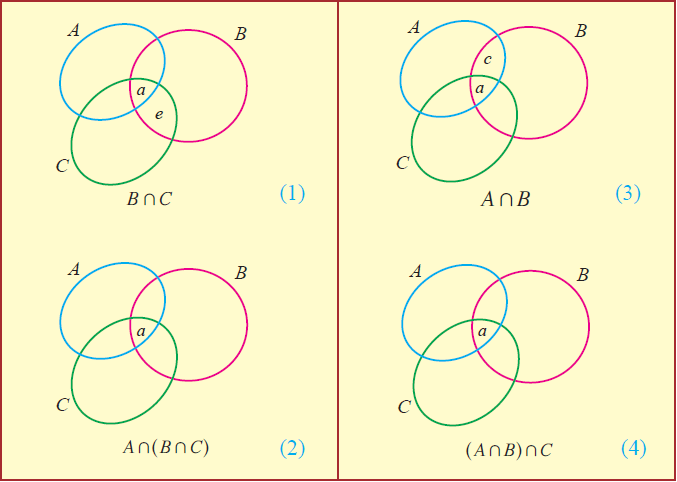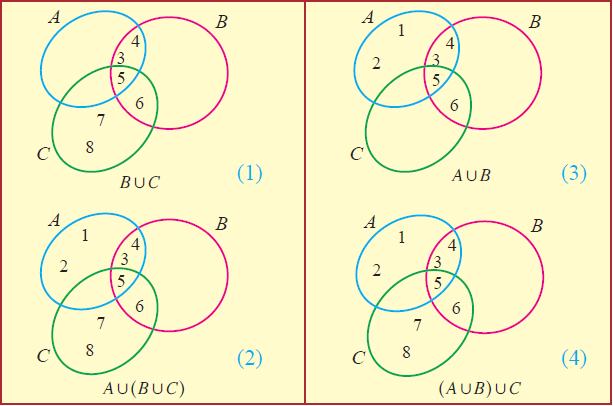About Lesson
Associative Law of Set
Associative Law states that the grouping of set operation does not change the result of next grouping of sets. It is one of the important concepts of set theory. If we have three sets A, B and C, then,
1. Associative Law of Intersection: (A ∩ B) ∩ C = A ∩ (B ∩ C)
2. Associative Law of Union: (A U B) U C = A U (B U C)
| Statement: |
| First Law: |
| First law states that the intersection of a set to the intersection of two other sets is the same. |
| (A ∩ B) ∩ C = A ∩ (B ∩ C) |
| Proof : |
| In the first law (A ∩ B) ∩ C = A ∩ (B ∩ C) |
| Step 1: |
| Let us take the L.H.S, (A ∩ B) ∩ C |
| Let x ∈ (A ∩ B) ∩ C. If x ∈ (A ∩ B) ∩ C then x ∈ (A and B) and x ∈ C |
| x ∈ (A and B) and x ∈ C |
| x ∈ (A and B) implies x ∈ A and x ∈ B |
| So, we have |
| x ∈ A, x ∈ B and x ∈ C |
| x ∈ A and x ∈ (B and C) |
| x ∈ A and (B and C) |
| x ∈ A ∩ (B ∩ C) |
| x ∈ (A ∩ B) ∩ C => x ∈ A ∩ (B ∩ C) |
| (A ∩ B) ∩ C ⊂ A ∩ (B ∩ C)— 1 |
| Step 2: |
| Let us take the R.H.S, (A ∩ B) ∩ C |
| Let x ∈ A ∩ (B ∩ C). If x ∈ A ∩ (B ∩ C) then x ∈ A and x ∈ (B and C) |
| x ∈ A and x ∈ (B and C) |
| x ∈ (B and C) implies x ∈ B and x ∈ C |
| So, we have |
| x ∈ A, x ∈ B and x ∈ C |
| x ∈ (A and B) and x ∈ C |
| x ∈ (A and B) and C |
| x ∈ (A ∩ B) ∩ C |
| x ∈ A ∩ (B ∩ C) => x ∈ (A ∩ B) ∩ C |
| A ∩ (B ∩ C) ⊂ (A ∩ B) ∩ C— 2 |
| From equation 1 and 2 |
| (A ∩ B) ∩ C = A ∩ (B ∩ C) |
|
Hence, associative law of sets for intersection has been proved.
|
 |
|
Second Law: |
| Second law states that the union of a set to the union of two other sets is the same. |
| (A ∪ B) ∪ C = A ∪ (B ∪ C) |
| Proof : |
| In the second law (A ∪ B) ∪ C = A ∪ (B ∪ C) |
| Step 1: |
| Let us take the L.H.S, (A ∪ B) ∪ C |
| Let x ∈ (A ∪ B) ∪ C. If x ∈ (A ∪ B) ∪ C then x ∈ (A or B) or x ∈ C |
| x ∈ (A or B) or x ∈ C |
| x ∈ (A or B) implies x ∈ A or x ∈ B |
| So, we have |
| x ∈ A or x ∈ B or x ∈ C |
| x ∈ A or x ∈ (B or C) |
| x ∈ A or (B or C) |
| x ∈ A ∪ (B ∪ C) |
| x ∈ (A ∪ B) ∪ C => x ∈ A ∪ (B ∪ C) |
| (A ∪ B) ∪ C ⊂ A ∪ (B ∪ C)— 3 |
| Step 2: |
| Let us take the R.H.S, (A ∪ B) ∪ C |
| Let x ∈ A ∪ (B ∪ C). If x ∈ A ∪ (B ∪ C) then x ∈ A or x ∈ (B or C) |
| x ∈ A or x ∈ (B or C) |
| x ∈ (B or C) implies x ∈ B or x ∈ C |
| So, we have |
| x ∈ A or x ∈ B or x ∈ C |
| x ∈ (A or B) or x ∈ C |
| x ∈ (A or B) or C |
| x ∈ (A ∪ B) ∪ C |
| x ∈ A ∪ (B ∪ C) => x ∈ (A ∪ B) ∪ C |
| A ∪ (B ∪ C) ⊂ (A ∪ B) ∪ C— 4 |
| From equation 3 and 4 |
| (A ∪ B) ∪ C = A ∪ (B ∪ C) |
|
Hence, associative law of sets for union has been proved.
|
